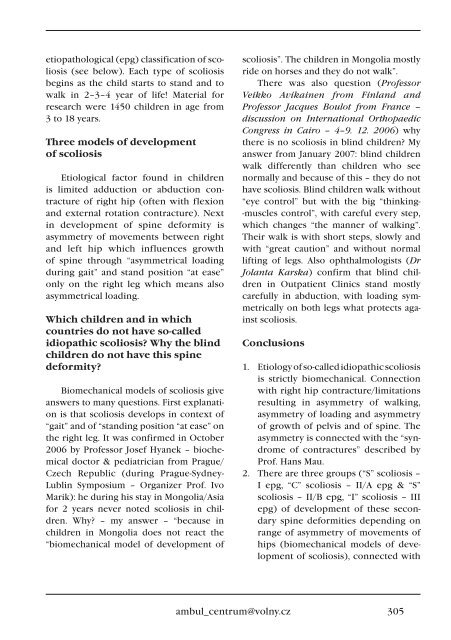Supplementum 3+4/2007 - SpoleÄnost pro pojivové tkánÄ›
Supplementum 3+4/2007 - SpoleÄnost pro pojivové tkánÄ›
Supplementum 3+4/2007 - SpoleÄnost pro pojivové tkánÄ›
You also want an ePaper? Increase the reach of your titles
YUMPU automatically turns print PDFs into web optimized ePapers that Google loves.
etiopathological (epg) classification of scoliosis<br />
(see below). Each type of scoliosis<br />
begins as the child starts to stand and to<br />
walk in 2–3–4 year of life! Material for<br />
research were 1450 children in age from<br />
3 to 18 years.<br />
Three models of development<br />
of scoliosis<br />
Etiological factor found in children<br />
is limited adduction or abduction contracture<br />
of right hip (often with flexion<br />
and external rotation contracture). Next<br />
in development of spine deformity is<br />
asymmetry of movements between right<br />
and left hip which influences growth<br />
of spine through “asymmetrical loading<br />
during gait” and stand position “at ease”<br />
only on the right leg which means also<br />
asymmetrical loading.<br />
Which children and in which<br />
countries do not have so-called<br />
idiopathic scoliosis Why the blind<br />
children do not have this spine<br />
deformity<br />
Biomechanical models of scoliosis give<br />
answers to many questions. First explanation<br />
is that scoliosis develops in context of<br />
“gait” and of “standing position “at ease” on<br />
the right leg. It was confirmed in October<br />
2006 by Professor Josef Hyanek – biochemical<br />
doctor & pediatrician from Prague/<br />
Czech Republic (during Prague-Sydney-<br />
Lublin Symposium – Organizer Prof. Ivo<br />
Marik): he during his stay in Mongolia/Asia<br />
for 2 years never noted scoliosis in children.<br />
Why – my answer – “because in<br />
children in Mongolia does not react the<br />
“biomechanical model of development of<br />
scoliosis”. The children in Mongolia mostly<br />
ride on horses and they do not walk”.<br />
There was also question (Professor<br />
Veikko Avikainen from Finland and<br />
Professor Jacques Boulot from France –<br />
discussion on International Orthopaedic<br />
Congress in Cairo – 4–9. 12. 2006) why<br />
there is no scoliosis in blind children My<br />
answer from January <strong>2007</strong>: blind children<br />
walk differently than children who see<br />
normally and because of this – they do not<br />
have scoliosis. Blind children walk without<br />
“eye control” but with the big “thinking-<br />
-muscles control”, with careful every step,<br />
which changes “the manner of walking”.<br />
Their walk is with short steps, slowly and<br />
with “great caution” and without normal<br />
lifting of legs. Also ophthalmologists (Dr<br />
Jolanta Karska) confirm that blind children<br />
in Outpatient Clinics stand mostly<br />
carefully in abduction, with loading symmetrically<br />
on both legs what <strong>pro</strong>tects against<br />
scoliosis.<br />
Conclusions<br />
1. Etiology of so-called idiopathic scoliosis<br />
is strictly biomechanical. Connection<br />
with right hip contracture/limitations<br />
resulting in asymmetry of walking,<br />
asymmetry of loading and asymmetry<br />
of growth of pelvis and of spine. The<br />
asymmetry is connected with the “syndrome<br />
of contractures” described by<br />
Prof. Hans Mau.<br />
2. There are three groups (“S” scoliosis –<br />
I epg, “C” scoliosis – II/A epg & “S”<br />
scoliosis – II/B epg, “I” scoliosis – III<br />
epg) of development of these secondary<br />
spine deformities depending on<br />
range of asymmetry of movements of<br />
hips (biomechanical models of development<br />
of scoliosis), connected with<br />
ambul_centrum@volny.cz<br />
305
















